principles of Urban Science 5
dr.federica bianco | fbb.space | fedhere | fedhere


machine learning

this slide deck:
what is machine learning
machine learning best practices
issues in data ethics
epistemic transparency
where does the bias enter models
what is machine learning?
1
a model is a low dimensional representation of a higher dimensionality datase
the best way to think about it in the ML context:
what is a model?
what is machine learning?
[Machine Learning is the] field of study that gives computers the ability to learn without being explicitly programmed.
Arthur Samuel, 1959
what is machine learning?
model
parameters: slope, intercept
[Machine Learning is the] field of study that gives computers the ability to learn without being explicitly programmed.
Arthur Samuel, 1959


what is machine learning?
[Machine Learning is the] field of study that gives computers the ability to learn without being explicitly programmed.
Arthur Samuel, 1959
model
parameters: slope, intercept
data


what is machine learning?
ML: any model with parameters learnt from the data
Machine Learning models are parametrized representation of "reality" where the parameters are learned from finite sets of realizations of that reality
(note: learning by instance, e.g. nearest neighbours, may not comply to this definition)
Machine Learning is the disciplines that conceptualizes, studies, and applies those models.
Key Concept
what is machine learning?
used to:
- understand structure of feature space
- classify based on examples,
- regression (classification with infinitely small classes)
- understand which features are important in prediction (to get close to causality)
General ML points
unsupervised vs supervised learning
Clustering
partitioning the feature space so that the existing data is grouped (according to some target function!)
Clustering
partitioning the feature space so that the existing data is grouped (according to some target function!)
Unsupervised learning
- understanding structure
- anomaly detection
- dimensionality reduction
All features are observed for all datapoints
unsupervised vs supervised learning
Clustering
partitioning the feature space so that the existing data is grouped (according to some target function!)
Classifying & regression
finding functions of the variables that allow to predict unobserved properties of new observations
Unsupervised learning
- understanding structure
- anomaly detection
- dimensionality reduction
All features are observed for all datapoints
unsupervised vs supervised learning
Clustering
partitioning the feature space so that the existing data is grouped (according to some target function!)
Classifying & regression
finding functions of the variables that allow to predict unobserved properties of new observations
Unsupervised learning
- understanding structure
- anomaly detection
- dimensionality reduction
All features are observed for all datapoints
unsupervised vs supervised learning
Clustering
partitioning the feature space so that the existing data is grouped (according to some target function!)
Classifying & regression
finding functions of the variables that allow to predict unobserved properties of new observations
Unsupervised learning
- understanding structure
- anomaly detection
- dimensionality reduction
Supervised learning
- classification
- prediction
- feature selection
All features are observed for all datapoints
Some features are not observed for some data points we want to predict them.
unsupervised vs supervised learning
Unsupervised learning
Supervised learning
All features are observed for all datapoints
and we are looking for structure in the feature space
Some features are not observed for some data points we want to predict them.
The datapoints for which the target feature is observed are said to be "labeled"
Semi-supervised learning
Active learning
A small amount of labeled data is available. Data is cluster and clusters inherit labels
The code can interact with the user to update labels.
also...
unsupervised vs supervised learning
what is machine learning?
extract features and create models that allow prediction where the correct answer is known for a subset of the data
supervised learning
identify features and create models that allow to understand structure in the data
unsupervised learning
-
k-Nearest Neighbors
-
Regression
-
Support Vector Machines
-
Neural networks
-
Classification/Regression Trees
-
clustering
-
Principle Component Analsysis
-
Apriori (association rule)
train, test, and validate
2
validating a model
How do we measure if a model is good?
Accuracy
Precision
Recall
ROC
AOC
We will talk more about this later...
but for now focus on
regression performance metrics
validating a model
How do we measure if a model is good?
Accuracy
Precision
Recall
ROC
AOC
Absolute error
Squared error
Mean squared error
Root mean
squared error
Relative mean
squared error
R squared
We will talk more about this later...
but for now focus on
regression performance metrics
validating a model
How do we measure if a model is good?
Accuracy
Precision
Recall
ROC
AOC
Absolute error
Squared error
Mean squared error
Root mean
squared error
Relative mean
squared error
R squared
do you recognize these??
We will talk more about this later...
but for now focus on
regression performance metrics
validating a model
How do we measure if a model is good?
Accuracy
Precision
Recall
ROC
AOC
We will talk more about this later...
but for now focus on
regression performance metrics
Split the sample in test and training sets
Train on the training set
Test (measure accuracy) on the test set
validating a model
from sklearn.model_selection import train_test_split
def line(x, intercept, slope):
return slope * x + intercept
def chi2(args, x, y, s):
a, b = args
return sum((y - line(x, a, b))**2 / s)
x_train, x_test, y_train, y_test, s_train, s_test = train_test_split(
x, y, s, test_size=0.25, random_state=42)
initialGuess = (10, 1)
chi2Solution_goodsplit = minimize(chi2, initialGuess,
args=(x_train, y_train, s_train))
print("best fit parameters from the minimization of the chi squared: " +
"slope {:.2f}, intercept {:.2f}".format(*chi2Solution_goodsplit.x))
print("R square on training set: ", Rsquare(chi2Solution_goodsplit.x, x_train, y_train))
print("R square on test set: ", Rsquare(chi2Solution_goodsplit.x, x_test, y_test))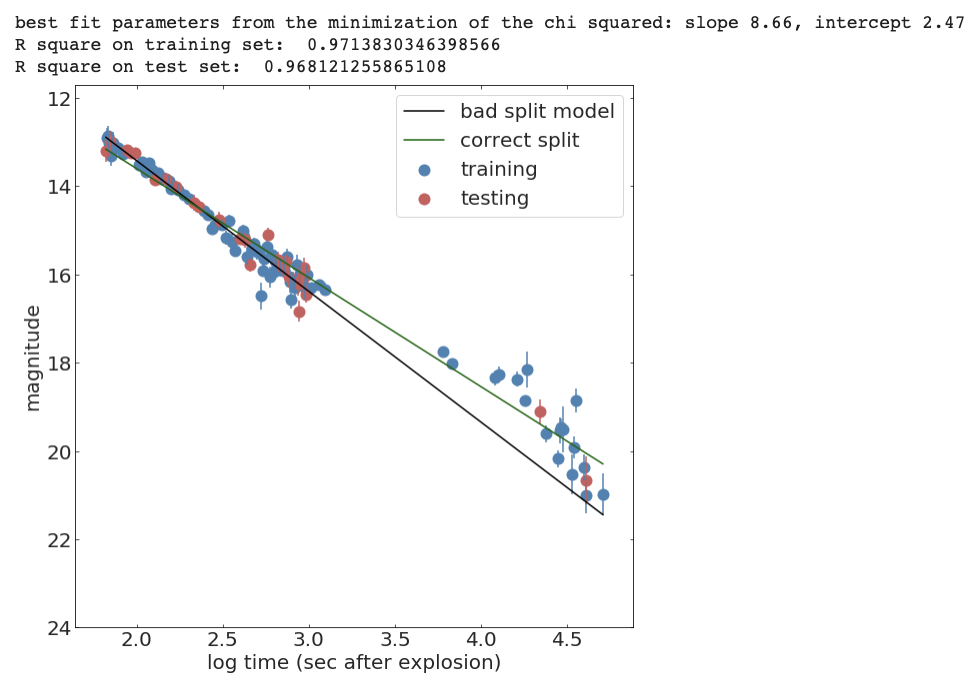
validating a model
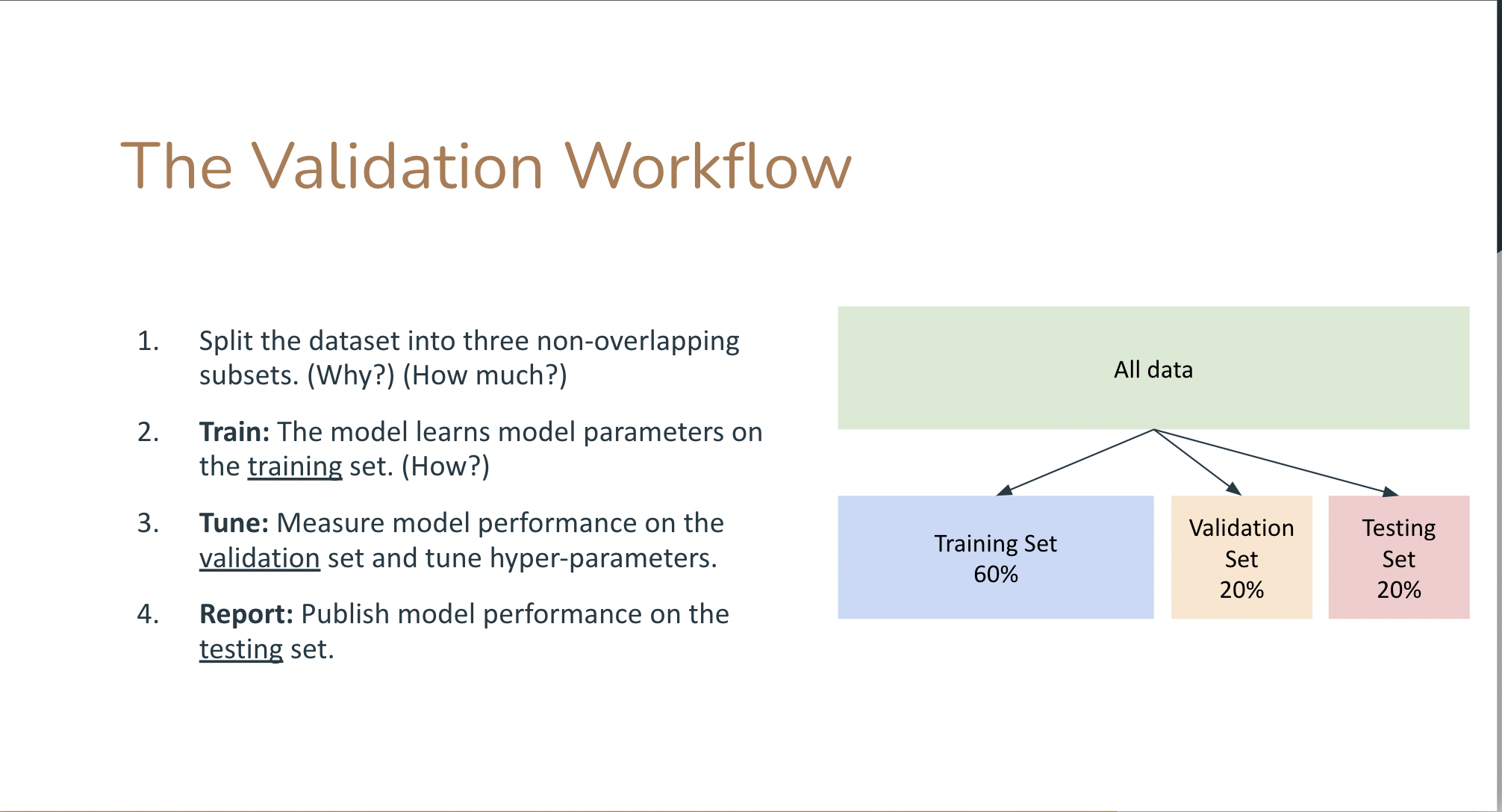
validating a model


validating a model
Cross validation
test train validation
train parameters on training set
run only once on the test set to assess the model performance
Cross validation
test + train + validation
train parameters on training set
adjust parameters on validation set
run only once on the test set to assess the model performance
Cross validation
k-fold cross validation

Cross validation

Model Selection
methods
2.2
ML standard
In ML models need to be "validated":
- split the data into a training and a test set (typical split 70/30).
- learn the model parameters by "training" the model on the training set
- "test" the model on the test set: measure the accuracy of the prediction (e.g. as the distance between the prediction and the test data).
The performance on the model is the performance achieved on the test set.
An upgrade on this workflow is to create a training, a test, and a validation test. Iterate between training and test to achieve optimal performance, then measure accuracy on the validation set.This is because you can use the test set performance to tune the model hyperparameters (model selection) but then you would report a performance that is tuned on the test set.
a significance performance degradation on the test compared to training set indicates that the model is "overtrained" and does not generalize well.
Model Selection
methods
2.2
HOW DO I CHOOSE A MODEL?
Given two models which is preferable?
Likelihood-ratio tests
likelihood ratio statistics LR
NESTED MODELS : one model contains the other one, e.g.
y= mx + l
is contained in
y=ax**2+ mx + l
statsmodels.model.compare_lr_ratio()
A rigorous answer (in terms of NHST) can be obtained for 2 nested models
This directly answers the question:
“is my more complex model overfitting the data?”
The LR statistics is expected to follow a χ^2 distrbution under the Null Hypothesis that the simpler model is preferable
HOW DO I CHOOSE A MODEL?
Given two models which is preferable?
Likelihood-ratio tests
NESTED MODELS : one model contains the other one, e.g.
y= mx + l
is contained in
y=ax**2+ mx + l
A rigorous answer (in terms of NHST) can be obtained for 2 nested models
This directly answers the question:
“is my more complex model overfitting the data?”
The LR statistics is expected to follow a χ^2 distrbution under the Null Hypothesis that the simpler model is preferable
from scipy.stats.distributions import chi2
def likelihood_ratio(llmin, llmax):
return(-2*(llmax-llmin))
LR = likelihood_ratio(L1,L2)
p = chi2.sf(LR, dof)
# dof: difference in number of parameters
print ('p: %.30f' % p)
# LR is chi squared distributed:
# p represents the probability that this result
# (or a more extreme result than this)
# would happen by chance
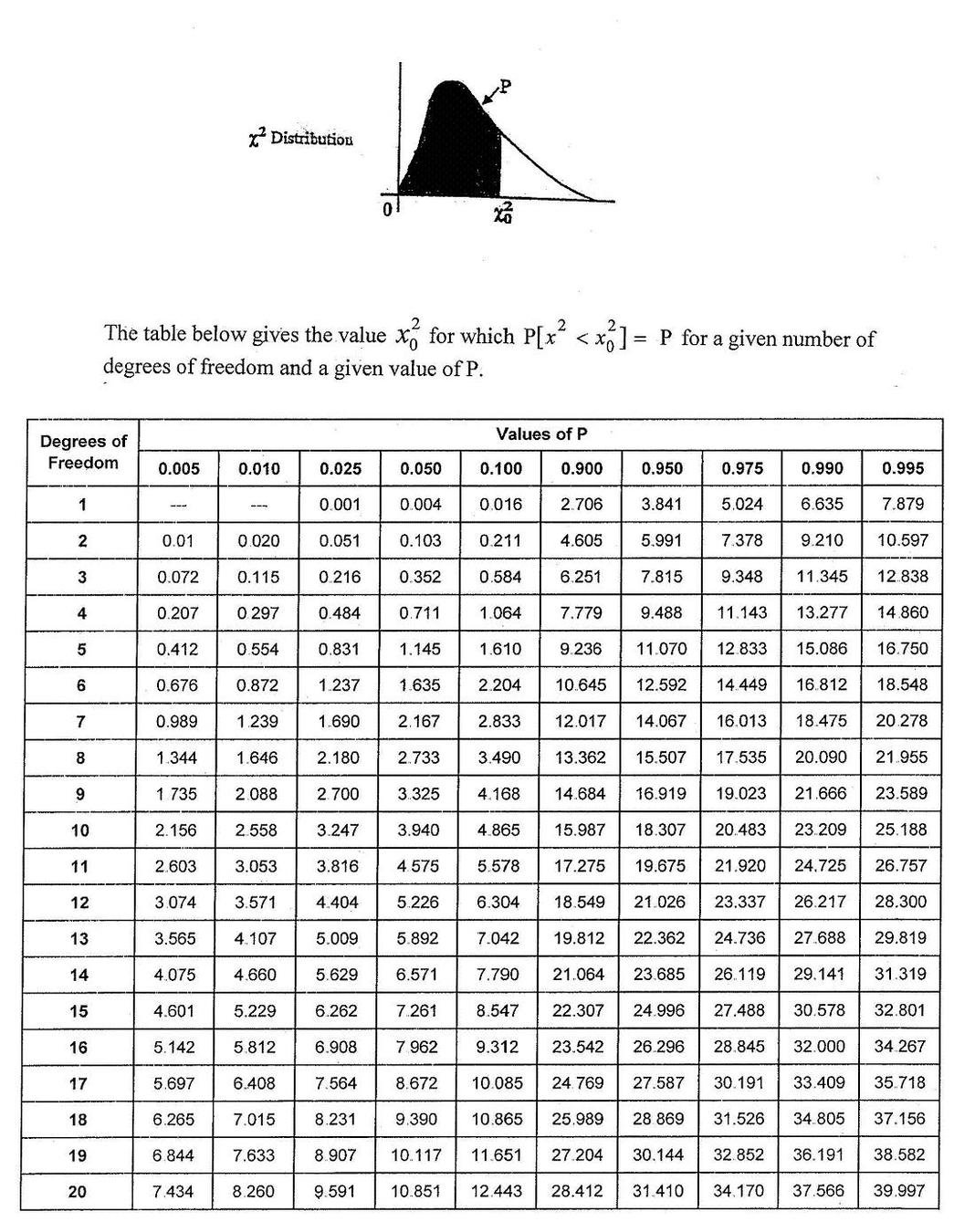
HOW DO I CHOOSE A MODEL?
Given two models which is preferable?
Likelihood-ratio tests
likelihood ratio statistics LR
statsmodels.model.compare_lr_ratio()
The LR statistics is expected to follow a χ^2 distrbution under the Null Hypothesis that the simpler model is preferable
difference in number of parameters between the 2 models
MLTSA:
model selection
Shannon 1948: A Mathematical Theory of Communication
a theory to find fundamental limits on signal processing and communication operations such as data compression
model selection is also based on the minimization of a quantity. Several quantities are suitable:
MLD
BIC
Bayese theorem
AIC
Optimism and likelihood maximization on the training set
MLTSA:
AIC, BIC, & MDL
number of parameters:
Model Complexity
Likelihood: Model Performance.
Akaike information criterion (AIC) .
Based on
where is a family of function (=densities) containing the correct (=true) function and is the set of parameters that maximized the likelihood L
L is the likelihood of the data, k is the number of parameters,
N the number of variables.
MLTSA:
AIC, BIC, & MDL
number of parameters:
Model Complexity
Likelihood: Model Performance.
"-" sign in front of the log-likelihood: AIC shrinks for better models,
AIC ~ k => is linearly proportional to the number of parameters
Akaike information criterion (AIC) .
Based on
where is a family of function (=densities) containing the correct (=true) function and is the set of parameters that maximized the likelihood L
L is the likelihood of the data, k is the number of parameters,
N the number of observations.
MLTSA:
AIC, BIC, & MDL
Likelihood: Model Performance.
number of parameters:
Model Complexity
Bayesian information criterion (BIC) .
L is the likelihood of the data, k is the number of parameters,
N the number of observations.
stronger penalization of complexity (as long as N> )
The derivation is very different:
Bayes Factor
MLTSA:
AIC, BIC, & MDL
Minimum Description Length (MDL) .
negative log-likelihood of the model parameters (θ) and the negative log-likelihood of the target values (y) given the input values (X) and the model parameters (θ).
also: log(L(θ)): number of bits required to represent the model,
log(L(y| X,θ)): number of bits required to represent the predictions on observations
minimize the encoding of the model and its predictions
derived from Shannon's theorem of information
MLTSA:
AIC, BIC, & MDL
Mathematically similar, though derived from different approaches. All used the same way: the preferred model is the model that minimized the estimator
MLTSA:
AIC, BIC, & MDL

HOW DO I CHOOSE A MODEL?
Given two models which is preferable?
AIC - BIC
also consider at Akaike and Bayesian Information Criteria for not nested models:
both are returned in a statsmodel fit
A rigorous answer (in terms of NHST) can be obtained for 2 nested models
This directly answers the question:
“is my more complex model overfitting the data?”
The LR statistics is expected to follow a χ^2 distrbution under the Null Hypothesis that the simpler model is preferable
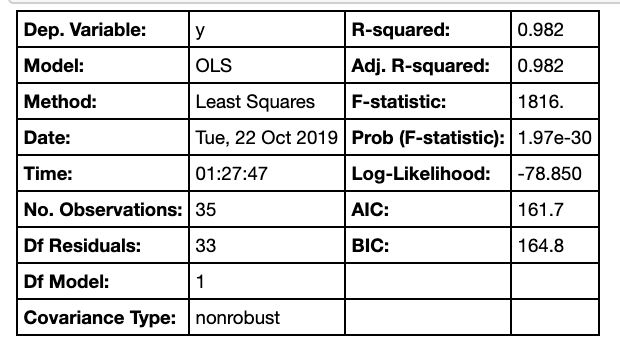
they are calculated combining the likelihood with a penalization for the extra parameters
generally both decrease with increasing increasing likelihood but you would look for the place where they start decreasing slowly as the "sweet spot" for your model
the principle of parsimony
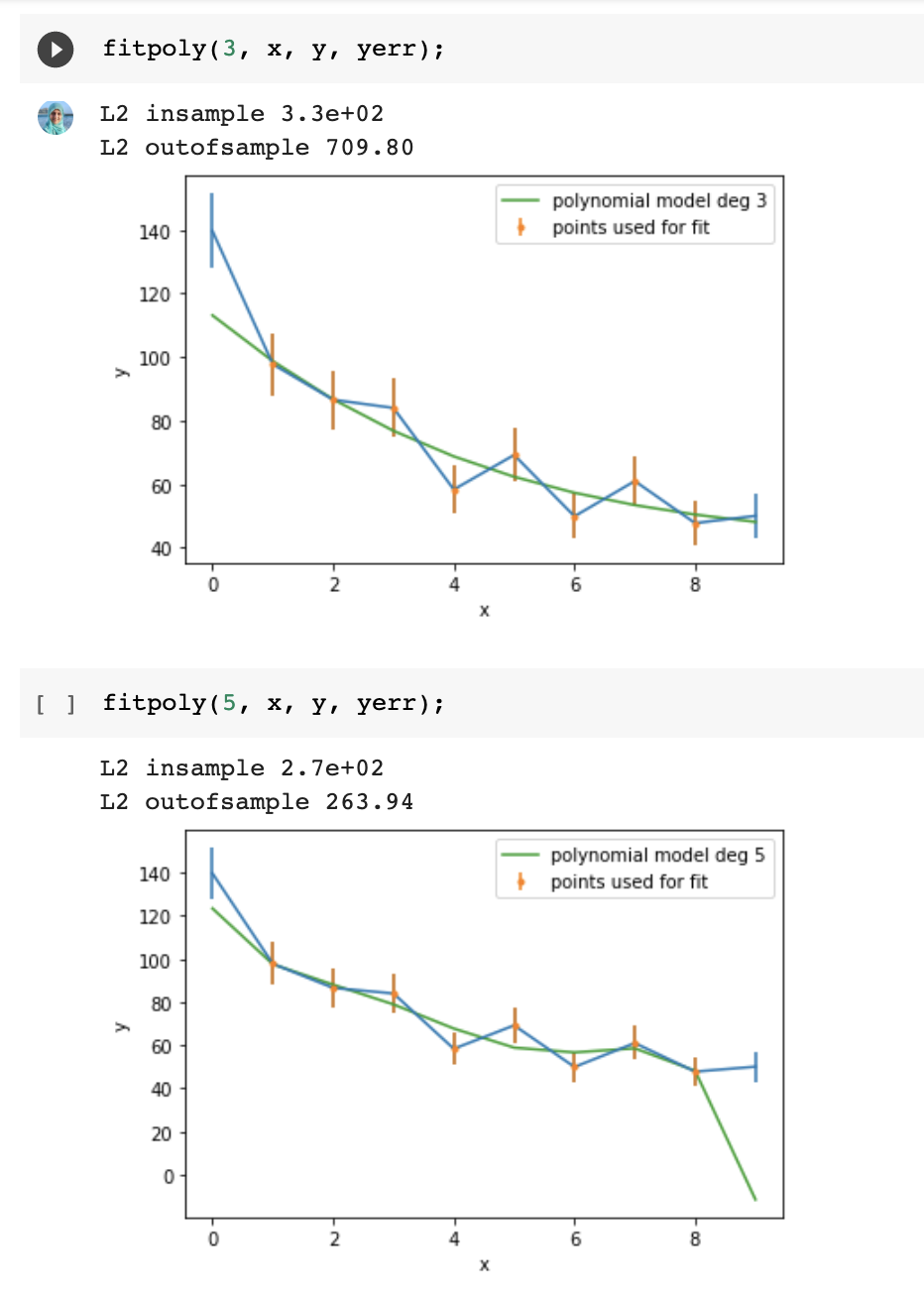
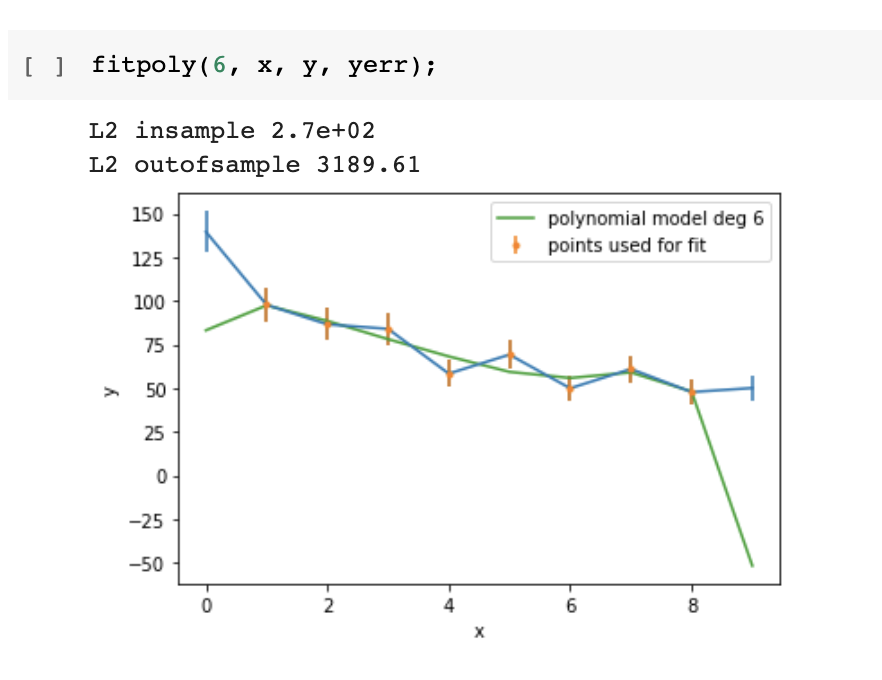

Careful!
Increasing the model's degrees freedom allows a "better fit" in the in-sample set
Logarithms

MONOTONICALLY INCREASING
if x grows, log(x) grows, if x decreases, log(x) decreases
the location of the maximum is the same!
Logarithms

SUPPORT :
MONOTONICALLY INCREASING
Logarithms

SUPPORT :
Not a problem cause L like P is positive defined
MONOTONICALLY INCREASING
likelihood, probability, and objective functions
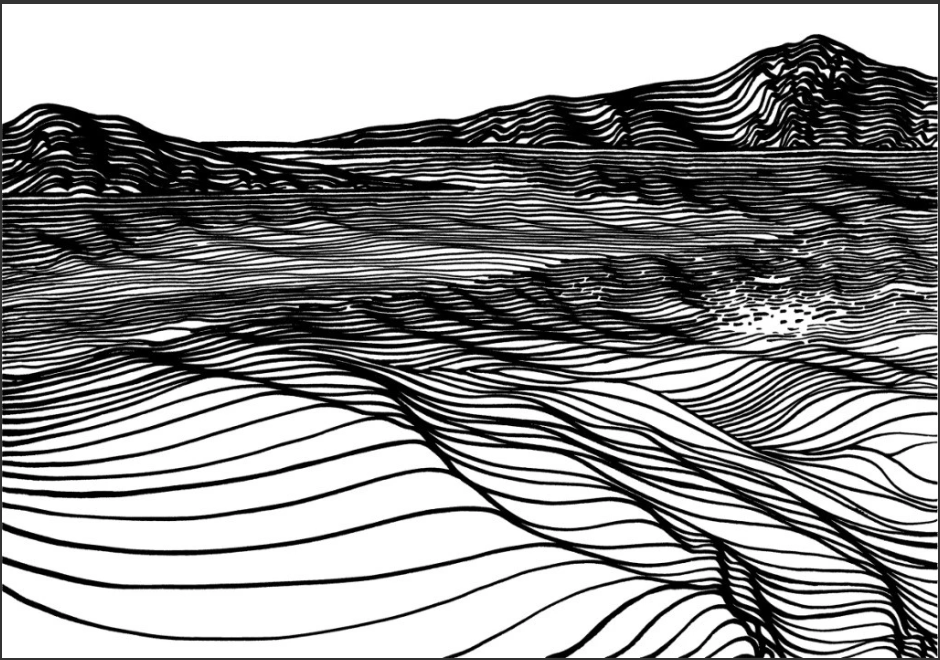
The problem of fitting models to data reduces to finding the
maximum likelihood
of the data given the model
This is effectively done by finding the minimum of the
-log(likelihood)
Summary
data ethics
3
intended and unintended consequences
https://www.un.org/en/chronicle/article/ideology-racism-misusing-science-justify-racial-discrimination
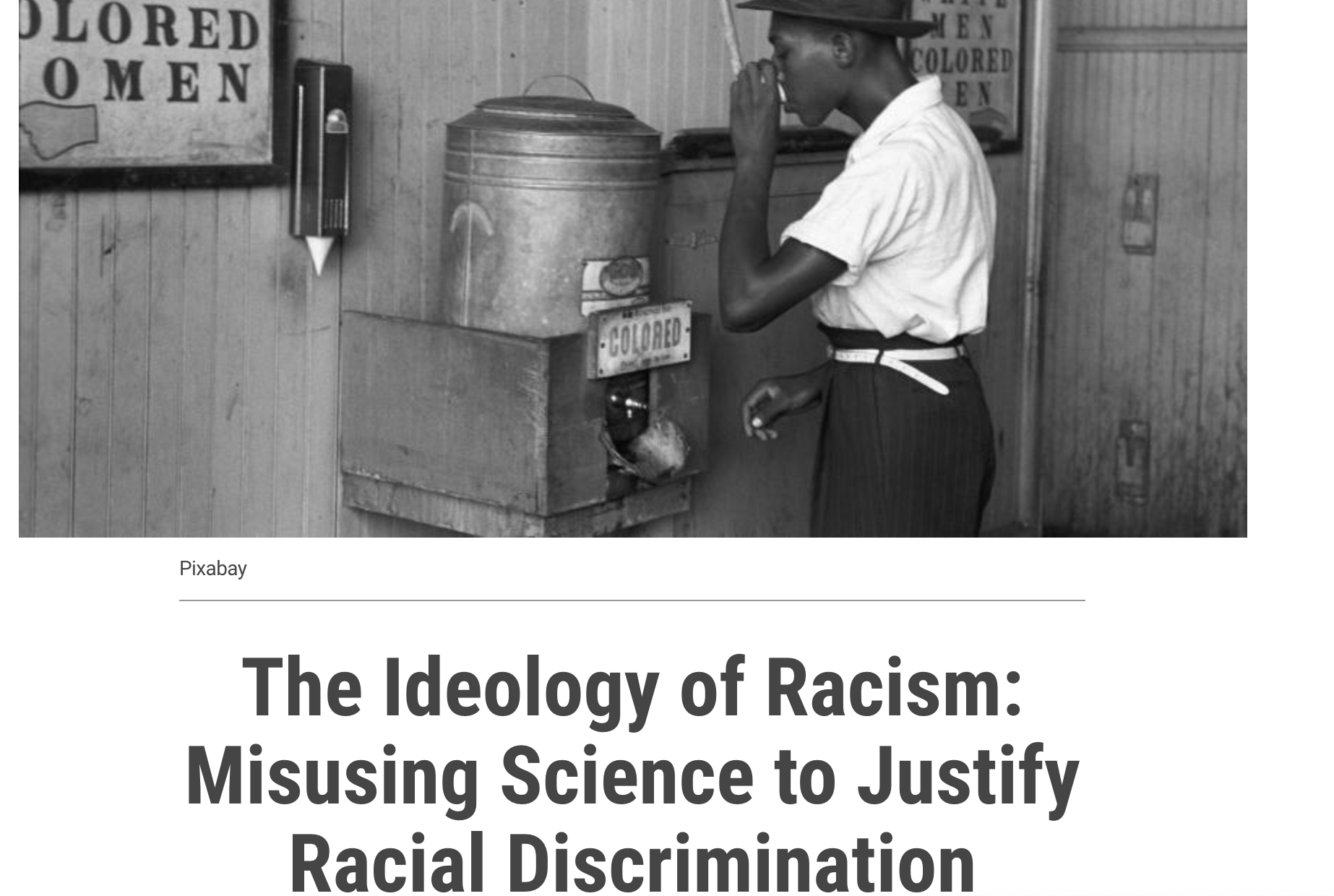
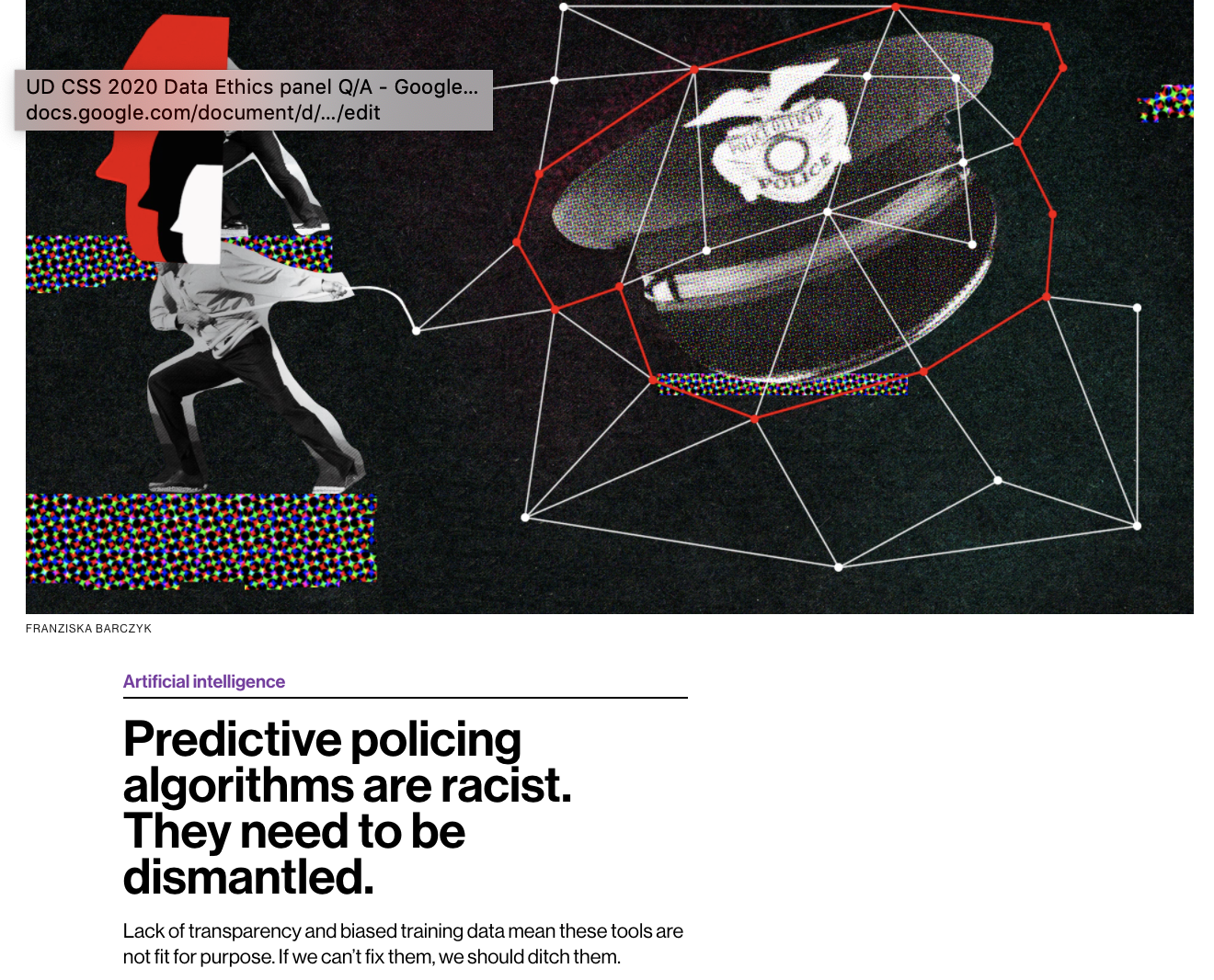
https://www.technologyreview.com/2020/07/17/1005396/predictive-policing-algorithms-racist-dismantled-machine-learning-bias-criminal-justice/
Data Science is a black box
Models are neutral, data is biased
two dangerous data-ethics myths



Data Science is a black box
machine learning models are
Epistemic transparency

tration by Hanne Morstad
Accountability: who is responsible if an algorithm does harm
algorithmic transparency
https://www.darpa.mil/attachments/XAIIndustryDay_Final.pptx
we are still trying to figure it out
we are still trying to figure it out
trivially intuitive
generalized additive models
decision trees
SVM
Random Forest
Deep Learning
Accuracy
univaraite
linear
regression
algorithmic transparency

#UDCSS2020

@fedhere
algorithmic transparency
https://www.darpa.mil/attachments/XAIProgramUpdate.pdf
we are still trying to figure it out
we are still trying to figure it out
trivially intuitive
generalized additive models
decision trees
SVM
Random Forest
Deep Learning
Accuracy in solving complex problems
univaraite
linear
regression
algorithmic transparency

#UDCSS2020

@fedhere
algorithmic transparency
we are still trying to figure it out
we are still trying to figure it out
trivially intuitive
generalized additive models
decision trees
Deep Learning
number of features that can be effectively included in the model
thousands
1
SVM
Random Forest
univaraite
linear
regression
https://www.darpa.mil/attachments/XAIProgramUpdate.pdf
algorithmic transparency

#UDCSS2020

@fedhere
Accuracy in solving complex problems
algorithmic transparency
we are still trying to figure it out
we are still trying to figure it out
trivially intuitive
univaraite
linear
regression
generalized additive models
decision trees
Deep Learning
SVM
Random Forest
https://www.darpa.mil/attachments/XAIProgramUpdate.pdf
time
algorithmic transparency

#UDCSS2020

@fedhere
Accuracy in solving complex problems
algorithmic transparency
1
Machine learning: any method that learns parameters from the data

2
The transparency of an algorithm is proportional to its complexity and the complexity of the data space
3
The transparency of an algorithm is limited by our own ability and preparedness to interpret it
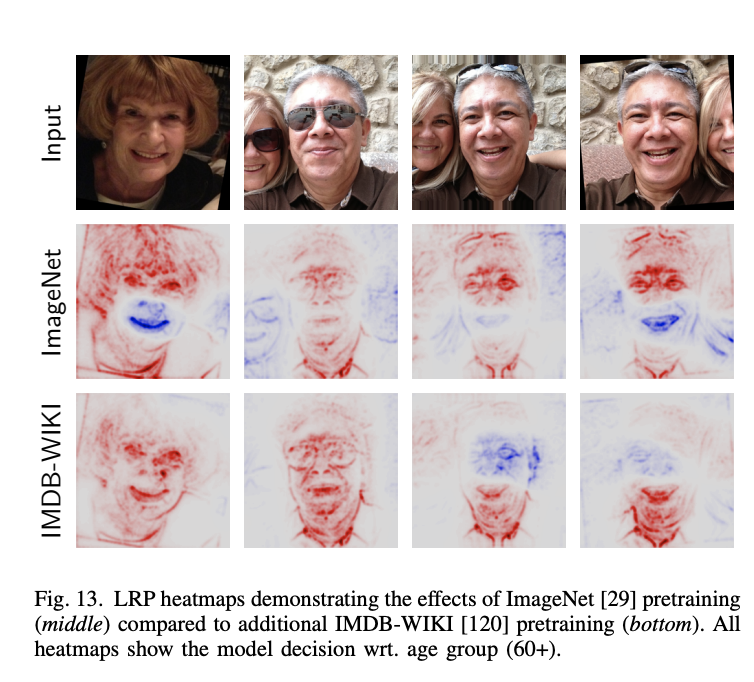



Toward Interpretable Machine Learning, Samek+2003
algorithmic transparency
models are neutral, the bias is in the data

Why does this AI model whitens Obama face?
Simple answer: the data is biased. The algorithm is fed more images of white people
Decide which model is appropriate (depends on data and question)
where is the bias?
1 - model selection
we are still trying to figure it out
we are still trying to figure it out
trivially intuitive
generalized additive models
decision trees
SVM
Random Forest
Deep Learning
Accuracy
univaraite
linear
regression

where is the bias?
Decide what your target function is
Machine learning models are functions that "learn" their parameters from the data.
They "learn" by minimizing or maximize some quantity.
What should you minimize?
https://towardsdatascience.com/machine-learning-fundamentals-via-linear-regression-41a5d11f5220
2 - cost function
where is the bias?
They "learn" by minimizing or maximize some quantity.
What should you minimize?
the hypothetical trolley problem suddenly is real
self-driving cars


2 - cost function
where is the bias?
They "learn" by minimizing or maximize some quantity.
What should you minimize?
prosecutorial justice
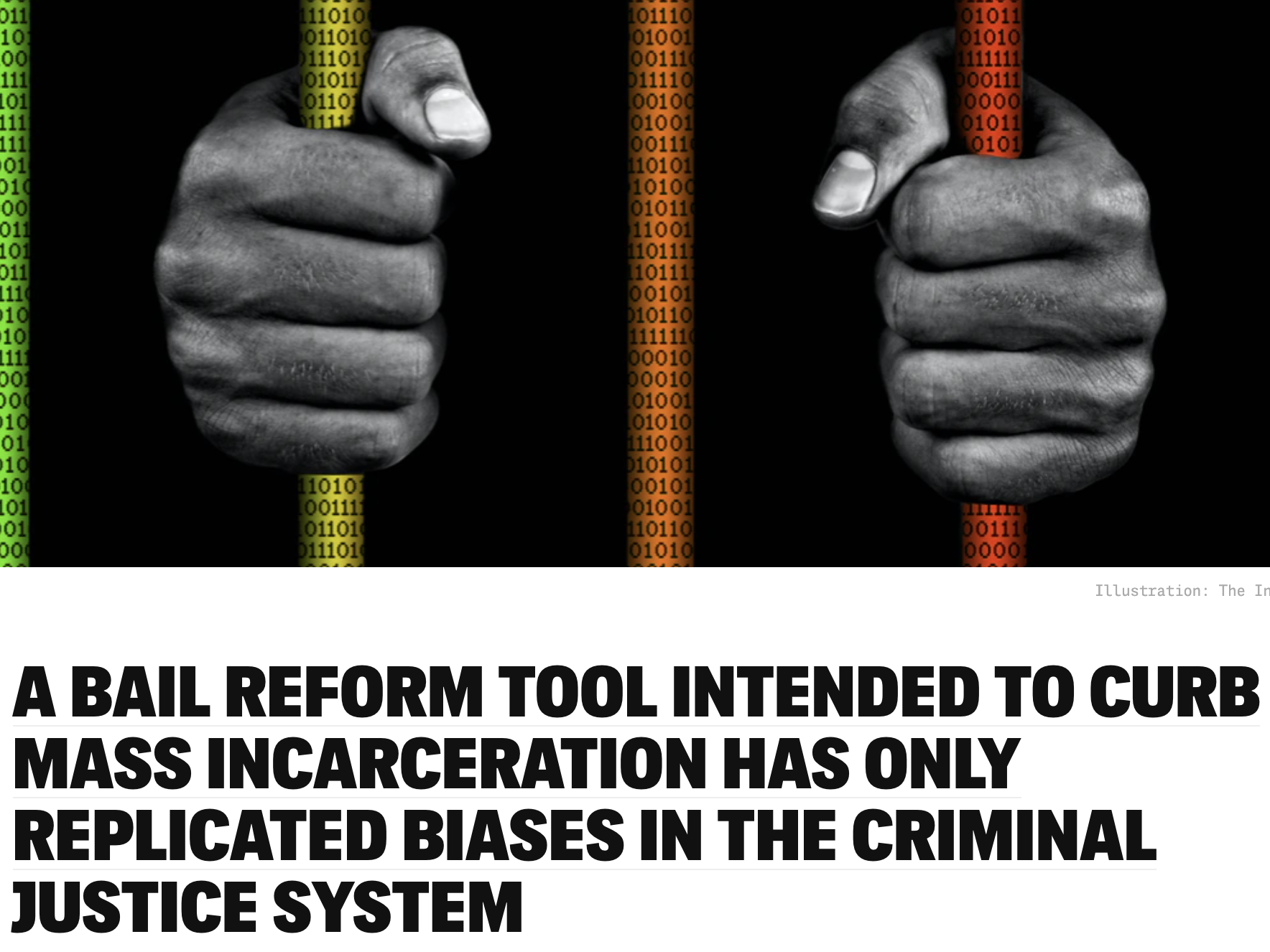
minimize number of people incarcerated injustly
maximize public safety
OR
2 - cost function
Explore the data
discover some of the bias
(trust me, there is more!)


it's not easy
there's covariance
missing data
where is the bias?
3 - data selection and preparation
remove the bias...
(few try)
models are neutral, the bias is in the data
Should AI reflect
who we are
(and enforce and grow our bias)
or should it reflect who we aspire to be?
(and who decides what that is?)
models are neutral, the bias is in the data
The bias is in the data
Should AI reflect
who we are
(and enforce and grow our bias)
or should it reflect who we aspire to be?
(and who decides what that is?)
models are neutral, the bias is in the data
The bias is in the data
The bias is in the models and the decision we make
Should AI reflect
who we are
(and enforce and grow our bias)
or should it reflect who we aspire to be?
(and who decides what that is?)
models are neutral, the bias is in the data
The bias is in the data
The bias is in the models and the decision we make
The bias is in how we choose to optimize our model
Should AI reflect
who we are
(and enforce and grow our bias)
or should it reflect who we aspire to be?
(and who decides what that is?)
models are neutral, the bias is in the data
The bias is in the data
The bias is in the models and the decision we make
The bias is in how we choose to optimize our model
Should AI reflect
who we are
(and enforce and grow our bias)
or should it reflect who we aspire to be?
(and who decides what that is?)
The bias is society that provides the framework to validate our biased models
models are neutral, the bias is in the data
The bias is in the data
The bias is in the models and the decision we make
The bias is in how we choose to optimize our model
The bias is society that provides the framework to validate our biased models
Should AI reflect
who we are
(and enforce and grow our bias)
or should it reflect who we aspire to be?
(and who decides what that is?)
key concepts
MACHINE LEARNING
- Machine Learning models are parametrized representation of "reality" where the parameters are learned from finite sets of realizations of that reality
- Unsupervised learning: all variables observed for all data, looking for natural grouping of datapoints in the N-dim space
- Supervised learning: a target variable is known for (a subset of) the data and the goal is to predict it for new (the rest of the) data
DATA ETHICS
- epistemic transparency:not all models are the same
- there is a tradeoff between epistemic transparency and the ability to handle complex data
- The bias enter data science in (at least) data; model selection; target function and optimization choices; validation
Text
references
homework
Midterm project due!
12/20 (regular homework timeline, no other homework)
Write a project proposal for your final projefollowing